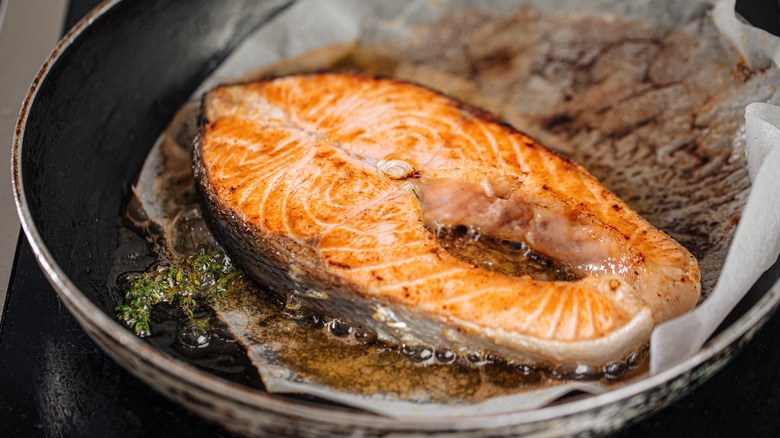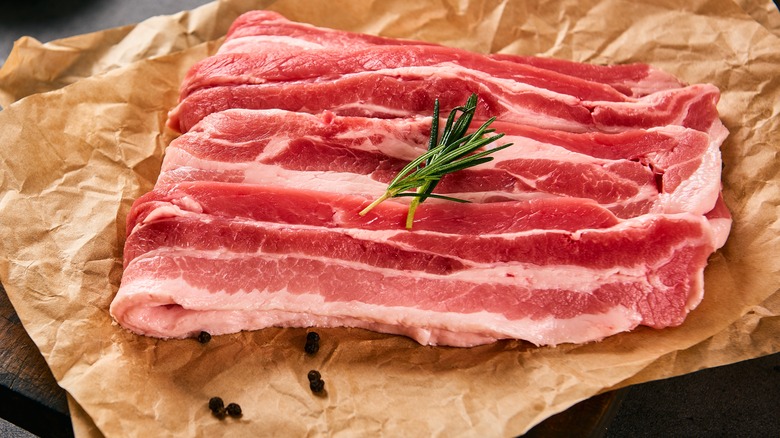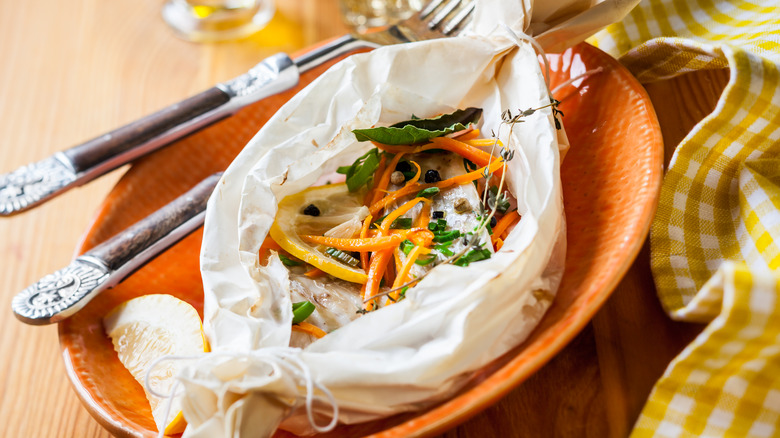The Safest Way To Use Parchment Paper In A Skillet
Parchment paper is a great multi-use tool in anyone's kitchen, from home chefs to seasoned professionals in the restaurant industry. It's incredibly heat-resistant and able to withstand temperatures up to 450 degrees Fahrenheit, so it can be used to line baking sheets and muffin tins, even skillets — all while providing a nonstick surface with easier cleanup.
Also called baking paper, parchment paper is made from wood pulp or cotton fiber coated in a thin layer of silicone, the same material used in reusable baking mats. This makes it nonstick, heat-resistant, and perfect for cooking and baking. The silicone coating in parchment paper also acts as an insulator and allows the paper to heat evenly. And, it will only contain the heat for a few minutes before cooling down, which makes it easy to handle right out of the oven.
In a hot skillet, you can use parchment paper for frying eggs, searing meat, reheating pizza, cooking hash browns, roasting bacon, or anything else you might use a skillet for. As an added benefit, since it's also oil-resistant, parchment paper helps to use less oil while cooking. However, there are some safety tips to keep in mind when using parchment paper in this way, including monitoring the temperature and trimming pieces to avoid fires.
Safety tips for using parchment paper in a skillet
Even though parchment paper can withstand high temps, it's still flammable, and therefore it's important to keep some safety tips in mind to avoid mishaps like kitchen fires.
Depending on the formula used for a particular brand, the allowable temperature range is typically between 420 to 450 degrees Fahrenheit. Still, it's best to go by the information listed on the individual package. Anything over 500 degrees Fahrenheit, the same temperature most nonstick pans can reach, increases the likelihood that parchment paper will catch flames. Cast iron skillets can reach even higher temperatures, up to 650 degrees Fahrenheit, so you'll really need to monitor the heat with a thermometer in that scenario.
It's also likely that, the smaller the paper, the lower the temperature it'll top out at, so be mindful of that fact when trimming parchment paper to use in a skillet. The best idea is to use scissors to cut square or circle pieces that fit neatly in the pan, add some oil, then flip the paper so it becomes coated on both sides. It's a good idea to trim the paper so nothing is left hanging over the pan that could catch fire, especially if you have a gas range that produces an open flame. Parchment paper is also fragile and tears easily, so avoid sharp utensils that could poke holes and allow hot oil to squirt out.
Other ways to use parchment paper while cooking
Outside of a skillet, several other cooking techniques work well with parchment paper. It can also used as a cartouche, a French technique for foods that need to simmer on the stove for an extended period. Also known as a "false lid," when parchment paper is placed over whatever food you might be cooking on the stove, such as soups or stews (or perhaps coffee-braised short ribs), it will help keep liquids from evaporating and prevent a skin from forming on the surface.
You can make a cartouche with a large piece of parchment paper folding it in half and then in half again, then continue to fold it on the diagonal into narrow triangles, similar to a fan. Cut off the tips to make a hole in the center of your cartouche, then cut along the outer edge so it fits inside the pot. Press the parchment lightly over the top of what you're cooking.
Another great cooking method for parchment paper is en papillote, wherein food such as fish, chicken, and vegetables are wrapped tightly in the material like an envelope and baked in the oven. The parchment paper is folded in tight pleats and then twisted at the end to seal the food inside. The process will steam dish as it cooks, for tender, moist results; the hot steam trapped inside the pouch allows food to cook quickly as well. For example, salmon cooked en papillote can be cooked to perfection in 15 minutes or less using this technique.



